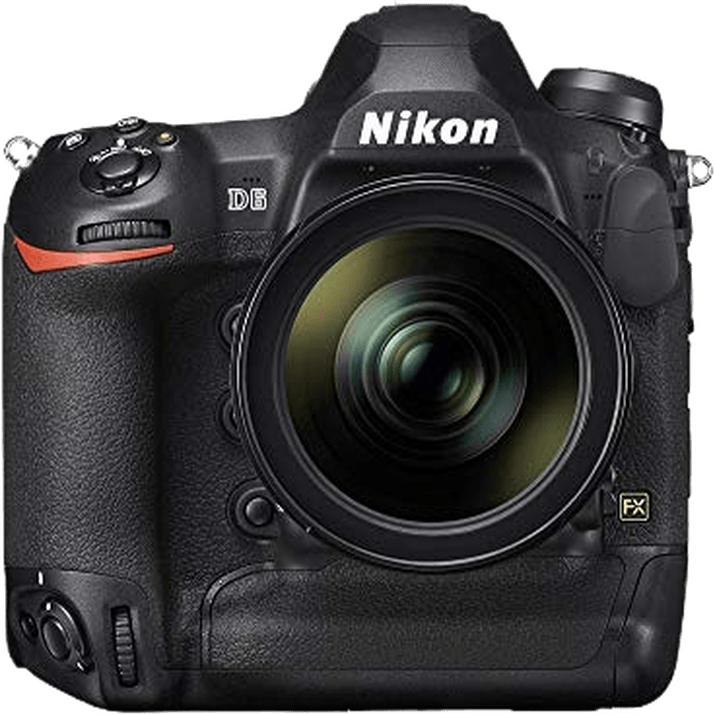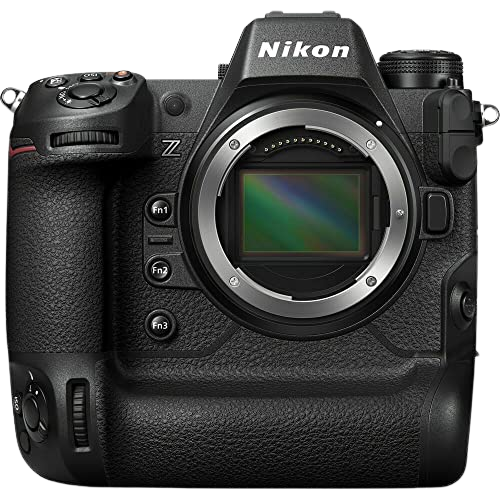Nikon D6 vs Z9 Comparison
Nikon D6

Nikon Z9

The Nikon Z9 edges out the Nikon D6 with a score of 87/100 compared to the D6’s 80/100. Both cameras, released in 2021 and 2020 respectively, share similarities in their specifications. Each has a launch price around $6000, with the Z9 being slightly more affordable at $5500.
The Z9 outshines the D6 in several aspects. As a mirrorless camera, it is lighter (1340g) and more compact (149 x 150 x 91mm) than the D6, a DSLR weighing 1450g and measuring 160 x 163 x 92mm. This makes the Z9 more portable and easier to handle during photography sessions.
On the other hand, the D6 still holds its ground as a reliable DSLR with a solid performance. However, the Z9’s advantages in weight, size, and price make it the more appealing choice for photographers seeking a high-quality camera with a modern touch.
Nikon D6 vs Z9 Overview and Optics
The Nikon Z9 emerges as the winner, outscoring the Nikon D6 by 13 points in the optics category, with a score of 88/100 compared to the D6’s 75/100. Both cameras share some common specifications, such as a CMOS sensor, full-frame sensor size, and a similar DXOMARK score for the sensor (97 for the D6 and 98 for the Z9). However, the Z9 outperforms the D6 in several key areas, making it the superior choice in terms of optics.
The Nikon Z9 has a significant advantage in megapixels, boasting a 46-megapixel sensor compared to the D6’s 20.8-megapixel sensor. This allows the Z9 to capture more detail and produce higher-resolution images. Additionally, the Z9 has a faster shooting speed of 30 frames per second (fps), compared to the D6’s 14 fps, making it better suited for capturing fast-moving subjects and action photography.
Another advantage of the Z9 is its Expeed 7 processor, which is an upgrade from the D6’s Expeed 6 processor. This results in improved image processing and performance. Furthermore, the Z9 has an image stabilization feature, which the D6 lacks, enabling the Z9 to capture sharper images in low-light conditions or when using slower shutter speeds.
The only area where the Nikon D6 has an advantage is its lens mount, which is the Nikon F mount. This allows the D6 to be compatible with a wider range of lenses. The Z9, on the other hand, uses the newer Nikon Z mount, which may have fewer compatible lenses available.
Taking all factors into consideration, the Nikon Z9 is the superior camera in terms of optics, offering higher resolution, faster shooting speed, an upgraded processor, and image stabilization. While the Nikon D6 may have an edge in lens compatibility, the Z9’s overall performance and features make it a better choice for photographers seeking exceptional image quality and performance.
Nikon D6 vs Z9 Video Performance
The Nikon Z9 outperforms the Nikon D6 in video capabilities, scoring a perfect 100/100 compared to the D6’s 83/100. Both cameras share some common video specifications, such as having a built-in time-lapse functionality. However, the Nikon Z9 surpasses the D6 in several key aspects.
The Z9 boasts a maximum video resolution of 8K, which is double the D6’s 4K resolution. This difference results in the Z9 producing significantly sharper and more detailed videos. The max video dimensions of the Z9 are 7680 x 4320, while the D6 offers 3840 x 2160. This substantial increase in dimensions provides more flexibility in post-production, allowing for better cropping and reframing options.
Another advantage of the Nikon Z9 is its maximum video frame rate of 120fps, which is double the D6’s 60fps. This higher frame rate enables the Z9 to capture smoother slow-motion footage, providing greater creative possibilities for videographers.
While the Nikon D6 falls short in comparison to the Z9’s video capabilities, it still offers solid video performance with its 4K resolution and 60fps frame rate. These features are suitable for most professional applications, and the built-in time-lapse functionality is a bonus for both cameras.
Ultimately, the Nikon Z9 excels in video capabilities, making it the superior choice for videographers seeking the highest-quality footage and creative options. The Nikon D6, while not as advanced in video performance, still provides reliable and professional-quality video for a variety of uses.
Nikon D6 vs Z9 Features and Benefits
The Nikon D6 and Nikon Z9 both have a feature score of 87 out of 100, indicating that these cameras are equally matched in terms of their features. Both cameras share several specifications, including a 3.2-inch screen size, touchscreen capability, GPS, WiFi, and Bluetooth connectivity.
The Nikon D6 outperforms the Nikon Z9 in screen resolution, with 2,359,000 dots compared to the Z9’s 2,088,960 dots. This higher resolution provides a clearer and sharper display, allowing for better image review and menu navigation.
On the other hand, the Nikon Z9 does not surpass the D6 in any specific feature. However, it is essential to consider that the Z9 matches the D6’s performance in all other aspects, which is an impressive accomplishment.
Considering the shared specifications and the D6’s advantage in screen resolution, it is evident that the Nikon D6 has a slight edge over the Nikon Z9 in terms of features. Nevertheless, the Nikon Z9 remains a strong competitor, as it offers the same level of performance as the D6 in most areas.
To conclude, the Nikon D6 and Nikon Z9 both have a high feature score, with the D6 having a minor advantage in screen resolution. The Z9 matches the D6 in all other aspects, making it a worthy contender. Ultimately, the choice between these two cameras will depend on individual preferences and the importance of the screen resolution to the user.
Nikon D6 vs Z9 Storage and Battery
The Nikon D6 outperforms the Nikon Z9 in storage and battery with a score of 100/100, compared to the Z9’s 79/100. Both cameras share common specifications, including two memory card slots and USB charging capabilities. They also accept CFexpress and XQD memory cards, with the Z9 additionally supporting SD, SDHC, and SDXC (UHS-II compatible) cards.
The D6 excels in battery life, offering 3580 shots per charge with its EN-EL18c battery, significantly more than the Z9’s 740 shots using the EN-EL18d battery. This extended battery life makes the D6 more suitable for extended shooting sessions without frequent battery changes.
On the other hand, the Z9 provides greater memory card compatibility, allowing for more storage options. Despite its lower battery life, the Z9’s versatility in memory card support may be advantageous for some users.
Considering the higher storage and battery score, the Nikon D6 stands as the superior choice in this aspect. However, the Nikon Z9’s broader memory card compatibility should not be overlooked for users who value storage versatility.
Nikon D6 vs Z9 – Our Verdict
Are you still undecided about which camera is right for you? Have a look at these popular comparisons that feature the Nikon D6 or the Nikon Z9:

